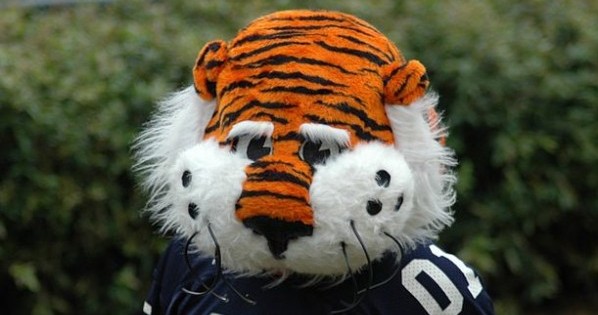
The first sports team I remember loving as a child, in the dim dewy days when I was two or three years old and just waking up to things that were not milk and mama or dirt and dogs, was the Fighting Irish of the University of Notre Dame. They were on television every day, it seemed, in our bustling brick Irish Catholic house. Inasmuch as I was hatched and coddled near Manhattan, there were also Metropolitans and Knickerbockers and Rangers and Islanders, and as I shuffled shyly into high school, I met snarling and roaring mammalian mascots, notably the Cougars of my own alma mater, which was plopped in marshlands where I doubt a cougar had been seen for 300 years.
Right about then I started paying attention to how we fetishize animals as symbols for our athletic adventures, and I have become more attentive since. For nearly 30 years now I have worked for colleges and universities; you could earn a degree in zoology just by reading the college sports news, where animals from anteater to wasp roar and fly and sprint and lope and canter and gallop and prowl. Among them, interestingly, are armadillos, bees, boll weevils, herons, owls, koalas, turtles, moose, penguins, gulls, sea lions, and squirrels, none of which seems especially intimidating or prepossessing—although I know a man in North Carolina who once lost a fistfight with a heron, and certainly many of us have run away from angry bees and moose, and surely there are some among us who could relate stories of furious boll weevils. But perhaps this is not the time, although anyone who has a story like that should see me right after class.
Mascottishly, there are vast numbers of canids (coyotes, foxes, huskies, salukis, great danes), felids (lions, tigers, panthers, lynx, bobcats), ruminants (bulls, chargers, broncs, broncos, and bronchoes, though no bronchials), mustelids (badgers, wolverine, otters), and denizens of sea and swamp (dolphins, gators, sharks, sailfish, and “seawolves,” or orca). There are two colleges that have an aggrieved camel as their mascot. There are schools represented by snakes and tomcats. There is a school whose symbol is a frog and one whose mascot is a large clam and one whose mascot famously is a slug. There is a school whose mascot is the black fly. There are the Fighting Turtles of the College of Insurance in New York. There are schools represented by lemmings and scorpions and spiders. There are the Stormy Petrels of Oglethorpe University in Georgia. There is a school represented by an animal that has never yet been seen in the Americas, the bearcat of Asia, although perhaps it is meant to be a wolverine, which did once inhabit southern Ohio, and may still live in Cincinnati, which has tough neighborhoods. The most popular mascot appears to be the eagle, especially if you count the 15 schools represented by golden eagles, which brings us to a round total of approximately 82 schools symbolized by the eagle, a creature Benjamin Franklin considered “a Bird of bad moral Character . . . too lazy to fish for himself . . . like those among Men who live by Sharping & Robbing he is generally poor and often very lousy. Besides he is a rank Coward.” But the two schools that Franklin helped establish are nicknamed the Quakers and the Diplomats, so we can safely ignore Ben on this matter.
This is not even to delve into the mysterious world of fantastical fauna—blue bears and blue tigers, crimson hawks, trolls, dragons and firebirds, griffins and griffons and gryphons, delta devils and jersey devils (there are a lot of devils, which makes you wonder about American character), jayhawks and kohawks and duhawks, green eagles and phoenixes, thunderhawks and thunderwolves—the mind reels; and then there is the whole subset of nicknamery that has to do with botany, as evidenced most memorably by the fighting Violets of New York University, on which image we had better pull this whole essay to the side of the road and sit silently for a moment, moaning gently.
Beyond all the obvious reasons we choose animals as symbols for our sporting teams—their incredible energy and muscle, grace and intelligence and verve, our ancient conviction of their power and magic, ancient associations as clan signs and tribal totems, even more ancient shivers perhaps of fear at animals who hunted and ate us, plus the way their images look cool on letterheads and sweatshirts and pennants and fundraising appeals—there is something else, something so deep and revelatory about human beings that I think we do not admit it because it is too sad.
I think we love animals as images because we miss them in the flesh, and I think we love them as images because they matter to us spiritually in ways we cannot hope to articulate. The vast majority of us will never see a cougar or a wolverine, never mind a boll weevil, but even wearing a riveting creature on a shirt, or shouting the miracle of its name in a stadium, or grinning to see its rippling beauty on the window of a car, gives us a tiny subtle crucial electric jolt in the heart, connects us somehow to what we used to be with animals: thrilled and terrified. We’ve lost the salt of that feeling forever, but even a hint of it matters immensely to us as animals too. Maybe that’s what we miss the most—the feeling that they are our cousins and not just clans of creatures who once filled the earth and now are shreds of memory, mere symbols, beings who used to be.

